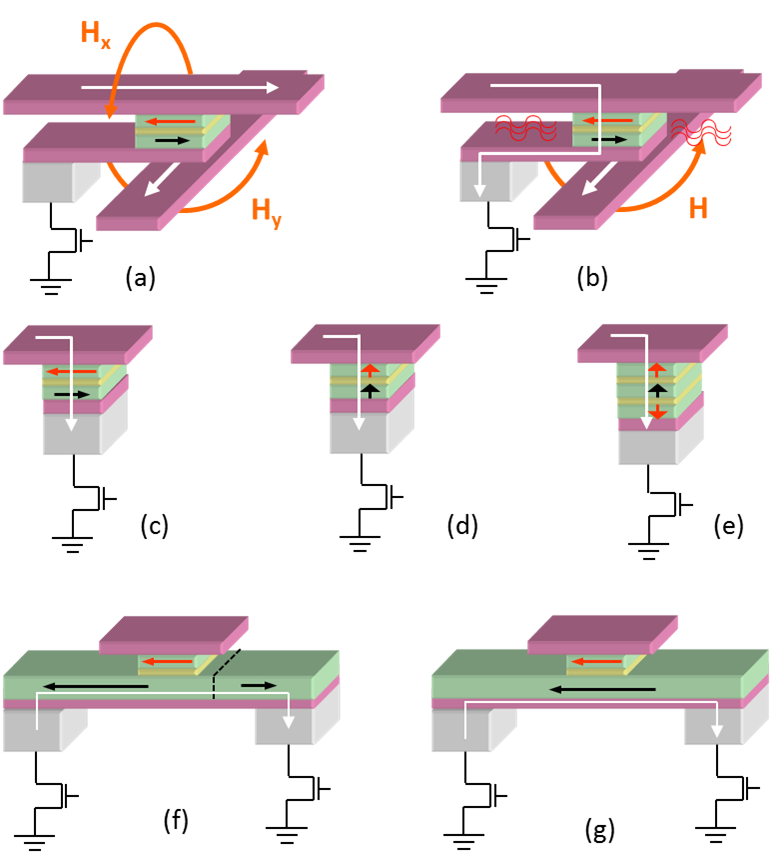Thematic overview
Magnetic Random Access Memories (MRAM) is a non-volatile memory technology, where information is stored by the magnetization direction of magnetic electrodes, very similar to computer hard-disk drives. The goal for MRAM memory is to simultaneously achieve high-speed read/write times, high density and unlimited cycling compared to other existing and emerging technologies.
Our group is developing advanced MRAM cell concepts patented at Spintec. The concepts are based on the use of temperature to reduce power consumption and increase the stability of the stored information. These ideas go beyond the conventional MRAM approach. The naturally occurring temperature increase during the write step is not lost, but is instead used to achieve the seemingly opposing goal of lowering the power consumption and increasing the thermal stability in the operating temperature range. Our group fosters young and experienced researchers developing/applying their expertise in the field of MRAM.

Questions to be addressed
Our main research axis is to use the naturally occurring temperature increase during the write step, when a current flows through the magnetic tunnel junction. The heating is used to go above a temperature threshold, making it possible to write the storage layer magnetization. This principle has been applied to in-plane magnetization cells using a storage layer pinned by an anti-ferromagnet and recently to perpendicular anisotropy cells. Our group’s goal is to demonstrate the proof-of-concept and then improve MRAM cell properties.
Our work involves the development of magnetic material systems, nano-fabrication (20-200nm cells), characterization of devices (magnetic & electrical) and simulation of the device behavior. Our activity in these vast fields is as follows;: On materials research, we are developing magnetic tunnel junctions with in-plane and perpendicular magnetic anisotropy. New electrode stacks having the material properties required by each specific concept need to be integrated in magnetic tunnel junctions, while achieving high levels of TMR signal. For the characterization of each concept we determine the write window parameters in terms of magnetic field, power consumption and magnetization reversal dynamics. Macrospin and micromagnetic simulation provide a better physical understanding of the system properties and the possibilities for optimization.
Projects
ANR EXCALYB – Perpendicular Anisotropy Materials for High-Density Non-volatile Magnetic Memory Cells
Crocus R&D – Thermally assisted MRAM
Samsung SGMI
Partners
Crocus Technology
Institut Néel
SP2M/NM
SAMSUNG
Applied Materials
SINGULUS
Recent news
- Seminar – Spins, Bits, and Flips: Essentials for High-Density Magnetic Random-Access Memory [June 20th, 2022]
On Thursday, July 7 at 14:00 we have the pleasure to welcome Dr. Tiffany SANTOS from Western Digital Corporation, CA, USA. She is 2022 IEEE Magnetics Society Distinguished Lecturer and will give us a seminar ... - PhD defense – Spintronic devices with reduced content of Platinum and Ruthenium [May 29th, 2022]
On Tuesday, June 7th at 14:00, M. Alvaro PALOMINO will defend his PhD thesis entitled: Spintronic devices with reduced content of Platinum and Ruthenium Place : CEA Bat. 10.05 Room 445 Zoom link https://univ-grenoble-alpes-fr.zoom.us/j/9618654716?pwd=MFNPYXRyU1N0R282d3lOYUovWm1HQT09 See access conditions at the end Abstract ... - Designing magnetic memory with improved retention and writability [April 08th, 2022]
Magnetic Random Access Memory recently started to be commercialized by all main microelectronics factories. In MRAM, the information is coded via parallel or antiparallel magnetic configurations to represent ones and zeroes. The technology is intrinsically ... - STOCHNET – An ANR project [December 09th, 2021]
STOCHNET stands for Hybrid Stochastic Tunnel Junction Circuits for Optimization and Inference. The motivation behind StochNet is to explore — through experimental demonstrations with hybrid CMOS stochastic tunnel junction circuits and simulations of theoretical ... - A new spintronic memristive component for neuromorphic circuits [November 18th, 2021]
Neuromorphic computing is a bio-inspired technology which aims at mimicking the brain working principles. It can be used for fast and energy-efficient applications through the implementation of networks of artificial neurons and synapses. Artificial synapses ...

SOUSA Ricardo
ricardo.sousa@cea.fr

BALTZ Vincent
vincent.baltz@cea.fr

PREJBEANU Lucian
lucian.prejbeanu@cea.fr

DIENY Bernard
bernard.dieny@cea.fr





